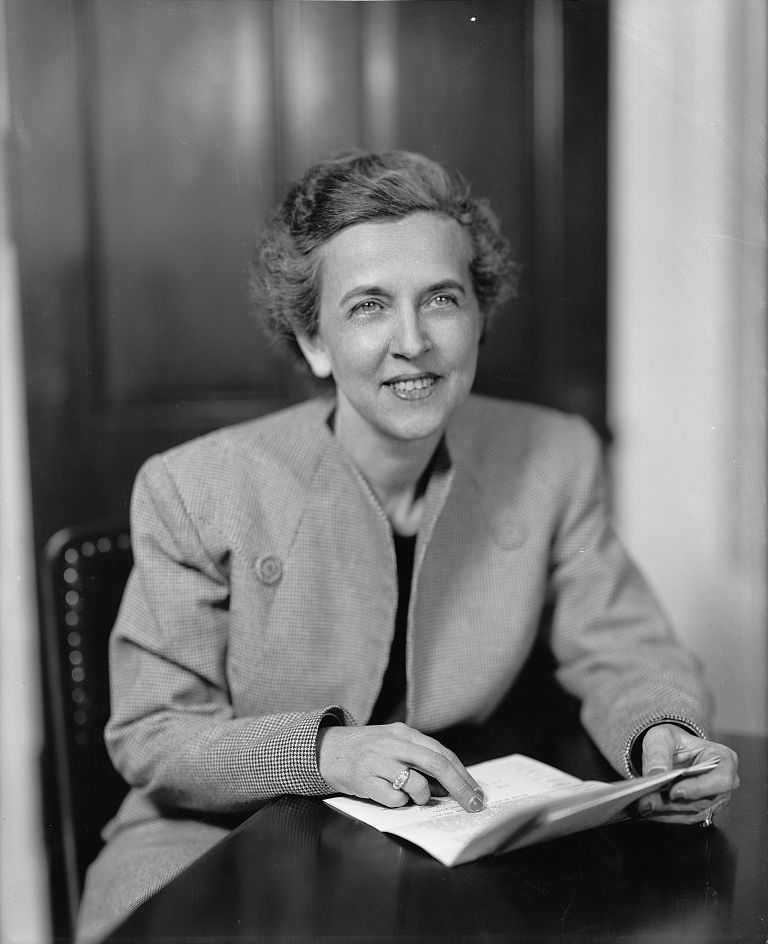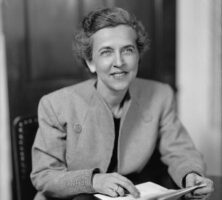Helen Douglas Mankin, lawyer and legislator, was the second woman elected to the U.S. Congress from Georgia.
She won in a special election on February 12, 1946, with a deciding margin of votes cast by African Americans. It was Black voters’ first major impact on Georgia politics since Reconstruction. Though Mankin won a large popular majority in the next general election, she was forced from office by Georgia’s white supremacist leadership, which invoked the state’s county unit system against her.

Born in Atlanta on September 11, 1894, she was the daughter of Corinne Williams and Hamilton Douglas, lawyers and educators, who had earned legal degrees together at the University of Michigan in 1887 and then moved to Atlanta, where Hamilton Douglas practiced law and helped found Atlanta Law School. Excluded from the Georgia bar as a woman, Corinne Douglas became a teacher and an innovator in women’s education.
A 1913 graduate of Atlanta’s Washington Seminary, Mankin earned an A.B. at Rockford College in Illinois in 1917. During 1918-19 she drove an ambulance in war-scarred France for an American hospital supported by suffragists, then returned home to earn an LL.B. from Atlanta Law School in 1920. She and her mother, then sixty-one years old, were together admitted to the Georgia bar in 1921, when the ban on women was lifted, and both joined the Douglas family firm. In 1924 Mankin established a small practice of her own, supplementing her income by lecturing at Atlanta Law School.
Major changes occurred in her life in 1927. She became active in city politics, serving as women’s manager of I. N. Ragsdale’s successful mayoral campaign. And on September 11, their mutual birthday, she married Guy Mark Mankin, an engineer and widower with a seven-year-old son. During the next five years, her husband’s career took them to Cuba, Brazil, Argentina, New York, and Chicago. In 1933 the couple returned to Atlanta, where Mankin resumed her law practice and began lobbying the Georgia legislature to ratify a child labor amendment to the federal constitution. When this effort failed, she decided to try “from inside.”
Running against five male opponents in the 1936 Democratic primary, she won a two-year term as state representative from Fulton County and was reelected four times, serving from 1937 to 1946—longer than any woman before her. With her imposing figure and independent, forthright, and abrasive personality, Mankin was the legislature’s first “strong” woman member. An opponent of powerful Governor Eugene Talmadge (1933-37, 1941-43), she promoted electoral reform, child welfare, labor causes, and improvements in the educational and prison systems. During the administration of Governor Ellis Arnall (1943-46), she championed his liberal reforms, such as repeal of the poll tax and enfranchisement of eighteen-year-olds.
When U.S. congressman Robert Ramspeck of the Fifth District resigned in 1946, Governor Arnall called a special election in February to fill the unexpired term, and Mankin left the legislature to seek the seat. In 1944 the Democratic white primary, long tantamount to election in the region’s one-party states, had been outlawed by the U.S. Supreme Court. Georgia, which claimed immunity from the decision, by 1946 was the defendant in a lawsuit seeking full implementation of the court’s intent. In this special election, however, the white primary, though still available, was not invoked, and African Americans, holding new hope for the franchise, doubled their registration for it. Mankin was the only candidate of the seventeen in the race who sought their support, and she won, 11,099 votes to 10,329 for her nearest opponent. Until the heavily Black precinct 3-B on Ashby Street reported, the last to do so, Mankin had been narrowly behind, but 3-B delivered Mankin 963 of its 1,039 votes, a winning margin.
Running again for governor, Eugene Talmadge called her “the Belle of Ashby Street” and heaped scorn on “the spectacle of Atlanta negroes sending a Congresswoman to Washington.” Mankin refused to disavow her Black supporters, declaring, “I’m proud of every one of those votes and I hope I’ll get them again.” She also drew support from labor and white progressives, becoming the focus of a Black-white voting alliance that Georgia’s dominant groups had feared since the Populist uprising of the 1890s.
In Washington, Mankin stood out as a Georgia maverick. A consistent supporter of U.S. president Harry S. Truman’s administration, she was among the few southerners who upheld his veto of the Case antistrike bill, which labor strongly opposed.
In April 1946 the U.S. Supreme Court struck down Georgia’s Democratic white primary, and in the party’s July primary Mankin was renominated to Congress by 53,611 votes to 42,482 for her principal opponent, James C. Davis, but under Georgia’s county unit system Davis was declared the winner. Designed to favor rural areas, the county unit system had not been used in the urbanized Fifth District since 1932, and it was resurrected to nullify the African American vote and “to beat Mrs. Mankin—nothing else,” declared William Schley Howard, a former congressman. Under the system the candidate receiving a plurality of a county’s popular vote was awarded all its assigned unit votes; the one with the most unit votes won the election. Mankin won her large popular majority in Fulton County, giving her its six unit votes, but she lost to Davis the eight unit votes of the district’s smaller counties. Mankin challenged the outcome, and the State Democratic Executive Committee, loyal to outgoing Governor Arnall, put both candidates on the general election ballot for the November general election, a rare procedure.
But Talmadge, having won the gubernatorial nomination, had Mankin’s name removed when he inherited control of the state committee before the general election. Mankin organized a last-minute write-in candidacy but encountered violent opposition from a white supremacy group known as the Columbians, who worked closely with Davis’s staff; despite obstacles she received 19,527 write-in votes to Davis’s 31,444 regular ballots. She challenged Davis’s right to a seat, but the Eightieth Congress upheld him. Racial disturbances in the South sparked national demands for civil rights laws, which further excited tempers in the region, and as Mankin’s public positions placed her among advocates of racial justice, the atmosphere was heavily charged when she ran against Davis again in 1948. This time her defeat was decisive.
Mankin continued her law practice but never again held public office. In 1950 she initiated a federal suit, South v. Peters, against the county unit system. The Supreme Court ruled against her, holding the system was a political issue in which it was powerless to intervene, a ruling that was reversed in 1962 in Baker v. Carr, the court’s “one man, one vote” case. Mankin did not live to see the reversal. Her election had inspired an upsurge in Black voter registration and participation and, as the Atlanta Constitution stated on November 7, 1982, “Georgia politics haven’t been the same since.” In 1956 she died in Atlanta from injuries suffered in an automobile accident.





